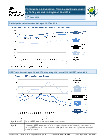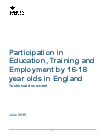Participation in education, training and employment is the highest since records began

The department has published new figures today (27 Jun) showing that the proportion of 16-18 year olds in education and apprenticeships has increased to 81.3% – the highest since records began 25 years ago.
Apprenticeships and Skills Minister Anne Milton said:
“I’m pleased that the proportion of 16-18 year olds in education and apprenticeships has increased to 81.3% – the highest since records began 25 years ago.
“We want more young people to have the opportunity to learn new skills, get the jobs they want and build successful careers. Our new T Levels will offer young people high-quality technical courses on a par with the best in the world. Our changes to apprenticeships mean they are now longer, higher-quality and with more off-the-job training”.
Updates to national participation figures for the end of 2017, released in June 2018, and provisional estimates for the end of 2018.
Documents

Main text
PDF, 1.7MB, 15 pages
This file may not be suitable for users of assistive technology. Request an accessible format.
If you use assistive technology (such as a screen reader) and need aversion of this document in a more accessible format, please email [email protected] .Please tell us what format you need. It will help us if you say what assistive technology you use.
Main tables
MS Excel Spreadsheet, 191KB
This file may not be suitable for users of assistive technology. Request an accessible format.
If you use assistive technology (such as a screen reader) and need aversion of this document in a more accessible format, please email [email protected] .Please tell us what format you need. It will help us if you say what assistive technology you use.
Additional tables – numbers
MS Excel Spreadsheet, 1.03MB
This file may not be suitable for users of assistive technology. Request an accessible format.
If you use assistive technology (such as a screen reader) and need aversion of this document in a more accessible format, please email [email protected] .Please tell us what format you need. It will help us if you say what assistive technology you use.
Additional tables – rates
MS Excel Spreadsheet, 1.02MB
This file may not be suitable for users of assistive technology. Request an accessible format.
If you use assistive technology (such as a screen reader) and need aversion of this document in a more accessible format, please email [email protected] .Please tell us what format you need. It will help us if you say what assistive technology you use.
Underlying data: numbers and rates
ZIP, 651KB
This file may not be suitable for users of assistive technology. Request an accessible format.
If you use assistive technology (such as a screen reader) and need aversion of this document in a more accessible format, please email [email protected] .Please tell us what format you need. It will help us if you say what assistive technology you use.

Technical document: data sources and methodology
PDF, 1.28MB, 20 pages
This file may not be suitable for users of assistive technology. Request an accessible format.
If you use assistive technology (such as a screen reader) and need aversion of this document in a more accessible format, please email [email protected] .Please tell us what format you need. It will help us if you say what assistive technology you use.
Pre-release access list
HTML
Details
This statistical release provides national participation in education, training and employment figures for 16 to 18 year olds to the end of 2018.
It contains information from different post-16 learning options, including:
- school
- further education colleges
- apprenticeships
- higher education
Headline measures are the percentages of 16 to 18 year olds:
- in education and apprenticeships
- who are not in education, employment or training
Breakdowns are set out by:
- age
- gender
- mode of study
- type of learning
- institution type (for example, further education colleges, schools)
- labour market status
- highest qualification being studied
The additional tables show figures dating from 1985.












Responses